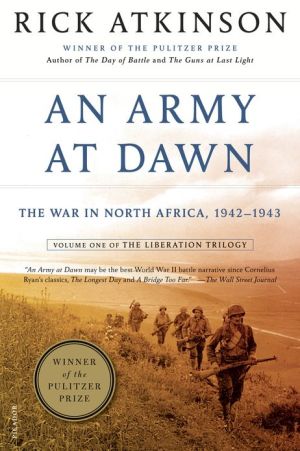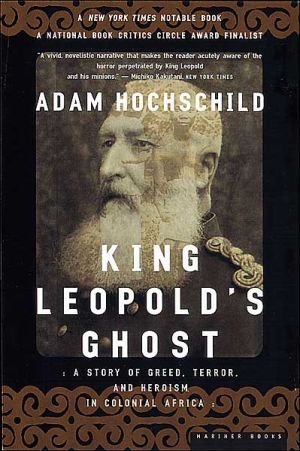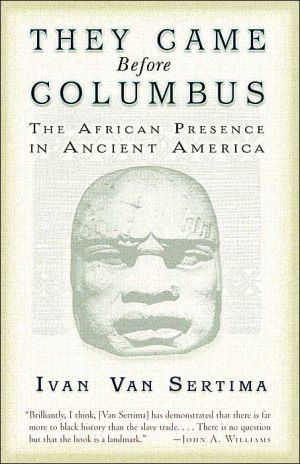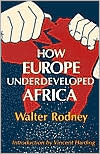An Army at Dawn: The War in North Africa, 1942-1943
"A splendid book... The emphasis throughout is on the human drama of men at war."—The Washington Post Book World\ \ The liberation of Europe and the destruction of the Third Reich is an epic story of courage and calamity, of miscalculation and enduring triumph. In this first volume of the Liberation Trilogy, Rick Atkinson shows why no modern reader can understand the ultimate victory of the Allied powers without a grasp of the great drama that unfolded in North Africa in 1942 and 1943.\...
Search in google:
The successful liberation of Europe from the Third Reich by the Allied powers could not have occurred without the perilous drama that unfolded in North Africa in 1942 and 1943. Now Rick Atkinson provides listeners with the definitive account of the war in North Africa that is vividly recounted, meticulously sourced, and as compelling as it is authoritative. Listeners follow the Americans and British in their seven-month struggle against the Axis armies in Tunisia, which leads from the failed assault at Longstop Hill, to the debacle at Kasserine Pass, and finally to the Allied victory and surrender of quarter million German and Italian troops in May 1943. John S. D. Eisenhower . . . His account will be a monument among accounts of World War II.
\ Chapter 1 A few minutes past 10 a.m. on Wednesday, October 21, 1942, a twin-engine Navy passenger plane broke through the low overcast blanketing Washington, D.C., then banked over the Potomac River for the final approach to Anacostia Field. As the white dome of the Capitol loomed into view, Rear Admiral Henry Kent Hewitt allowed himself a small sigh of relief. Before dawn, Hewitt had decided to fly to Washington from his headquarters near Norfolk rather than endure the five-hour drive across Virginia. But thick weather abruptly closed in, and for an anxious hour the aircraft had circled the capital, probing for a break in the clouds. Usually a man of genial forbearance, Hewitt chafed with impatience at the delay. President Roosevelt himself had summoned him to the White House for this secret meeting, and although the session was likely to be little more than a courtesy call, it would never do for the man chosen to strike the first American blow in the liberation of Europe to keep his commander-in-chief waiting.\ Kent Hewitt seemed an unlikely warrior. Now fifty-five, he had a high, bookish forehead and graying hair. Double chins formed a fleshy creel at his throat, and on a ship’s bridge, in his everyday uniform, he appeared “a fat, bedraggled figure in khaki,” as a British admiral once observed with more accuracy than kindness. Even the fine uniform he wore this morning fit like blue rummage, notwithstanding the flag officer’s gold braid that trimmed his cuffs. A native of Hackensack, New Jersey, Hewitt was the son of a mechanical engineer and the grandson of a former president of the Trenton Iron Works. One uncle had been mayor of New York, another the superintendent of the Metropolitan Museum of Art. Kent chose the Navy, but as a midshipman in the Annapolis sail loft he was said to have been so frightened of heights that he “squeezed the tar out of the rigging.” As a young swain he had enjoyed dancing the turkey trot; in recent decades, though, he was more likely to be fiddling with his slide rule or attending a meeting of his Masonic lodge.\ Yet Hewitt had become a formidable sea dog. Aboard the battleship U.S.S. Missouri, he circled the globe for fifteen months with Theodore Roosevelt’s Great White Fleet, displaying such a knack for navigation that the stars seemed to eat from his hand. As a destroyer captain in World War I, he had won the Navy Cross for heroism. Later he chaired the Naval Academy’s mathematics department, and for two years after the invasion of Poland he ran convoy escorts between Newfoundland and Iceland, ferrying war matériel across the North Atlantic.\ In April 1942, Hewitt had been ordered to Hampton Roads to command the Atlantic Fleet’s new Amphibious Force; late that summer came Roosevelt’s decision to seize North Africa in Operation TORCH. Two great armadas would carry more than 100,000 troops to the invasion beaches. One fleet would sail 2,800 miles from Britain to Algeria, with mostly British ships ferrying mostly American soldiers. The other fleet, designated Task Force 34, was Hewitt’s. He was to sail 4,500 miles to Morocco from Hampton Roads and other U.S. ports with more than 100 American ships bearing 33,843 American soldiers. In a message on October 13, General Eisenhower, the TORCH commander, had reduced the mission to twenty-six words: “The object of the operations as a whole is to occupy French Morocco and Algeria with a view to the earliest possible subsequent occupation of Tunisia.” The Allies’ larger ambition in TORCH had been spelled out by Roosevelt and Churchill: “complete control of North Africa from the Atlantic to the Red Sea.”\ Through a tiny window over the plane’s wing, Hewitt could see the full glory of Indian summer in the nation’s capital. Great smears of color—crimson and orange, amber and dying green—extended from the elms around the Lincoln Memorial to the oaks and maples beyond the National Cathedral. Across the Potomac, the new Pentagon building filled Hell’s Bottom between Arlington Cemetery and the river. Jokes had already begun circulating about the immense five-sided maze, including the story of a Western Union boy who entered the Pentagon on a Friday and emerged on Monday as a lieutenant colonel. Though it now owned the world’s largest building, the Army was still leasing thirty-five other office complexes around the city, and cynics quipped that if the military were to seize enemy territory as quickly as it had conquered Washington, the war could end in a week.\ The plane settled onto the runway and taxied to a hangar. Hewitt buttoned his jacket and hurried down the steps to the Navy staff car waiting on the tarmac. The car sped through the airfield gate and across the Anacostia River to Pennsylvania Avenue. Hewitt had enough time to swing by the Navy Department building downtown and check there for messages before heading to the White House.\ “You do everything you can,” he liked to say, “then you hope for the best.” Since receiving the first top-secret orders for Task Force 34, he had done everything he could, to the verge of exhaustion. Every day brought new problems to solve, mistakes to fix, anxieties to quell. Rehearsals for the TORCH landings had been hurried and slipshod. With Axis predators sinking nearly 200 Allied vessels a month, including many along the American coast, all amphibious training had been moved inside the Chesapeake Bay, whose modest tides and gentle waves resembled not at all the ferocious surf typical of the Moroccan coast. During one exercise, only a single boat arrived on the designated beach, even though a lighthouse had provided a beacon on a clear night with a calm sea; the rest of the craft were scattered for miles along the Maryland shore. In another exercise, at Cove Point, ninety miles north of Norfolk, security broke down and the men stormed the beach to be greeted by an enterprising ice cream vendor. In Scotland, the training by troops bound for Algeria was going no better; sometimes it was conducted without the encumbrance of actual ships, because none were available. Troops moved on foot across an imaginary ocean toward an imaginary coast.\ Would the eight Vichy French divisions in North Africa fight? No one knew. Allied intelligence estimated that if those troops resisted stoutly, it could take Eisenhower’s forces three months just to begin the advance toward Tunisia. If U-boats torpedoed a transport during the Atlantic passage, how many destroyers should be left behind to pick up survivors? Hewitt was not certain he could spare any without jeopardizing the task force, and the prospect of abandoning men in the water gnawed at him. Had word of the expedition leaked? Every day he received reports that someone, somewhere had been talking too much. For the first months after its creation, the Amphibious Force was so secret that it used a New York City post office box as its mailing address. Only a select few now knew Hewitt’s destination, but the existence of a large American fleet designed to seize a hostile shore could hardly be kept secret anymore. A few weeks earlier, Hewitt had received a letter from Walt Disney—written on stationery with the embossed letterhead “Bambi: A Great Love Story”—who offered to design a logo for the Amphibious Force. Ever the gentleman, Hewitt wrote back on October 7 with polite, noncommittal thanks.\ The staff car crawled past Capitol Hill to Independence Avenue. Nationwide gasoline rationing would begin soon, but Washington’s population had nearly doubled in the last three years, and for now the streets were jammed. Coffee rationing would begin even sooner—one cup per person per day—and diners had started hoarding for special customers, like speakeasies stocking up on liquor just before Prohibition. Bawling newsboys on street corners shouted the day’s headlines from the various war fronts: fighting on Guadalcanal ebbs; Red Army at Stalingrad stops Nazi tank attacks; another American merchantman sunk in the Atlantic, the 500th U.S. ship lost to U-boats since Pearl Harbor. The domestic news was also war-related, if less febrile: the first meatless Tuesday had gone well in New York; penitentiary inmates with only one felony conviction were urged to apply for parole so they could serve in the Army; and a survey of department stores in Washington revealed that “there aren’t any nylon stockings to be had for love or money.”\ The car pulled up to the Navy Department’s blocky gray building, just south of the Mall. Hewitt climbed from the rear seat and hurried up the steps. He knew where all those stockings had gone. Flying from Norfolk that morning, he could see stevedores on the docks still trying to wedge 50,000 tons of food, gasoline, and munitions into the holds of ships moored across Hampton Roads. Among the secret cargoes in sealed crates were six tons of women’s stockings and lingerie, to be used for barter with Moroccan natives. Clandestine military buyers had swept clean the store shelves all along the Eastern Seaboard.\ For Hewitt, it was just another secret to keep. Since Roosevelt’s final decision on July 30, TORCH had grown so complex that planning documents now filled a pair of mail sacks, each weighing fifty pounds. Two issues in particular had occupied Anglo-American strategists, and in both instances the president—who referred to himself as “a pig-headed Dutchman”—had pressed his views relentlessly.\ First, he insisted that almost no British troops participate in the initial landings. A seething Anglophobia had spread through Vichy France in the past two years as a consequence of several unhappy incidents: Royal Air Force bombers had accidentally killed 500 French civilians while attacking a Renault plant outside Paris. British forces had intervened in the French overseas dependencies of Syria and Madagascar. Britain had also sponsored a failed attack on the French port at Dakar, Senegal, by the Free French forces of Charles de Gaulle, whom Marshal Pétain and many French officers considered an impertinent renegade. And worst of all, in July 1940 British warships had issued an ultimatum to the Vichy fleet at Mers el-Kébir, near Oran, Algeria: lest the French ships fall into German hands, the captains were told to sail for Britain or a neutral port. When the ultimatum was rejected, the British opened fire. In five minutes, they slaughtered 1,200 French sailors.\ “I am reasonably sure a simultaneous landing by British and Americans would result in full resistance by all French in Africa, whereas an initial landing without British ground forces offers a real chance that there would be no French resistance or only a token resistance,” Roosevelt cabled Churchill on August 30. To test this theory, the president commissioned a Princeton, New Jersey, firm to discreetly survey public opinion in North Africa. The poll results—drawn from a scientifically dubious sample of fewer than 150 respondents—reinforced Roosevelt’s conviction.\ There was skepticism in London. One British diplomat believed that Roosevelt’s “spirit of Lafayette” merely reflected a sentimental Yankee affection for Paris, “where all good Americans hoped to go in the afterlife.” But, having won on the larger issue of whether to invade Africa or France, Churchill chose to concur with the president. “I consider myself your lieutenant,” he cabled Roosevelt. “This is an American enterprise in which we are your help mates.” The president’s further suggestion that British forces wait a full month after the invasion before coming to North Africa was gently rebuffed; the plan now called for Tommies to follow hard on the heels of their Yank cousins in Algeria.\ The second vital issue involved where to land. Most British strategists, supported by Eisenhower, had stressed the importance of controlling Tunisia within two weeks of the invasion, before Axis troops from nearby Sicily and the Italian mainland could establish a bridgehead. “The whole conception of TORCH may stand or fall on this question of early Allied occupation of Tunisia,” a British message advised. Once Tunisia was held, Allied control of Mediterranean shipping was all but assured. Rommel’s Afrika Korps would be trapped in Libya, and the Allies would possess a southern springboard for further operations, against Sicily or the European continent.\ These considerations argued for putting invasion forces from both armadas onto Mediterranean beaches in Algeria, and perhaps even as far east as the principal Tunisian port of Bizerte. “We should take great risks” to reach Tunis first, the British military chiefs of staff urged. Landings too far west should be avoided “like the plague” because of the hazard that the subsequent advance “eastward will be so slow as to allow Germans to reach Tunisia in force.” In late August, Eisenhower’s preliminary TORCH plan called for landings entirely within the Mediterranean, at the Algerian ports of Oran, Algiers, and Bône.\ But General Marshall and War Department planners had other ideas. Tunisia and eastern Algeria lay within range of Axis warplanes on Sicily and beyond range of Allied fighters at Gibraltar. Landings at sites vulnerable to Luftwaffe attack would be extraordinarily perilous. Furthermore, the Americans feared that Hitler might lunge through neutral Spain and close the Straits of Gibraltar, trapping them in the Mediterranean as if cinching the drawstring of a sack. That argued for at least one landing on Morocco’s Atlantic coast to guarantee an open supply line across the Atlantic.\ For weeks, cables had fluttered back and forth in what Eisenhower called “a transatlantic essay contest.” The Royal Navy believed that although the Strait of Gibraltar at its narrowest was just eight miles wide, it could not be controlled by enemy forces any more than the English Channel had been controlled. British planners also calculated that even with Madrid’s consent to cross Spain—consent that, London insisted, was unlikely to be given—the Germans would need at least six divisions and more than two months to overpower Gibraltar.\ In the American view, however, the risks were too great. The TORCH landings must succeed, Marshall argued, because failure in the first big American offensive of the war would “only bring ridicule and loss of confidence.”\ Roosevelt agreed, and again he intervened. “I want to emphasize,” he cabled Churchill on August 30, “that under any circumstances one of our landings must be on the Atlantic.” The president blithely dismissed the notion that Axis forces might build a Tunisian redoubt before the Allies arrived. In another message to the prime minister, he reiterated “our belief that German air and parachute troops cannot get to Algiers or Tunis any large force for at least two weeks after [the] initial attack.”\ Again Churchill acquiesced, not least because General Brooke, chief of the Imperial General Staff, shared the American disquiet and believed that diverting Hewitt’s armada to Morocco “is a much wiser plan.”\ If not wiser, it was safer in the short run. But rarely are wars won in the short run. The Americans had been audacious to the point of folly in advocating SLEDGEHAMMER, the sacrificial landing of a mostly British force on the French coast. Now, with American soldiers predominant in TORCH, caution prevailed and audacity stole away. Hewitt’s Task Force 34 would deposit one-third of the invasion force more than a thousand miles from Tunis. The invaders would bifurcate themselves by facing east and west, violating the hallowed principle of concentration and weakening their Sunday punch. In London, Eisenhower changed the odds of quickly capturing Tunis from “the realm of the probable to the remotely possible.”\ On September 5, the final decision was made to attempt landings at three sites in Morocco and at half a dozen beaches around Algiers and Oran. “Please make it before election day,” Roosevelt asked Marshall. In this, the president would be disappointed. Various delays intruded, and on September 21, Eisenhower fixed the invasion date for Sunday morning, November 8, five days after the U.S. congressional elections.\ TORCH remained breathtakingly bold, an enterprise of imagination and power. But at a critical moment, the Allies had taken counsel of their fears. His business done at the Navy Department, Hewitt emerged at 1 p.m. to find that the day had turned warm and humid, with temperatures edging into the low seventies. The staff car picked him up and headed east on Independence Avenue before angling north across the Mall on 15th Street.\ At the White House, a Secret Service agent directed his driver through the southeast gate, then led Hewitt on a circuitous route to avoid nosy reporters. Walking through the narrow corridors, the admiral saw that the mansion was battened down for combat. Blackout curtains draped the windows, and skylights had been painted black. Every room in the old tinderbox was equipped with a bucket of sand and a shovel, along with folded gas masks. The cluttered Fish Room, where Roosevelt kept trophies from his angling expeditions, was a reminder of the admiral’s last encounter with the president. In December 1936, as skipper of the U.S.S. Indianapolis, Hewitt had taken Roosevelt on a monthlong trip to South America. He fondly remembered his passenger casting from the boat deck, then chortling with glee as he hauled in two fish. Roosevelt named them “Maine” and “Vermont,” for the two states he had failed to carry in his recent reelection.\ Waiting, as planned, in a small, vaulted antechamber of the Oval Office was the battle captain who would command the American troops in Morocco once Hewitt put them ashore: Major General George S. Patton, Jr. He, too, had been escorted by a roundabout route to avoid the press, but Patton was incapable of looking inconspicuous. Tall and immaculate in his starched pinks-and-greens, the crease in his trousers bayonet sharp, gloves folded just so in his left hand, Patton seemed every inch the warrior looking for a war.\ Even as he shook Patton’s hand and returned his broad smile, Hewitt remained uncertain what to make of this strange man. That he was a gifted and charismatic officer bound for glory seemed obvious. But, thoughtful and utterly charming one moment, he could be profane and truculent the next. Later in the war, military planners were to recommend at least six months’ preparation from the day an invasion order was issued to the day the fleet sailed; the belated decision to invade Morocco had given Task Force 34 only seven weeks to ready one of the most complex military operations in American history. George Patton seemed determined to make every hour as difficult as possible.\ Rather than move his headquarters to Hampton Roads, Patton had remained in his capacious office loft in the Munitions Building on the Mall, even as he railed against the “goddam fools in Washington.” “By all means, as I have already written you, come see us as soon as you can,” Hewitt wrote in exasperation. Without consulting the Navy, Army planners proposed Moroccan landing sites, one of which had no beach and another of which was boobytrapped with shoals. In recent days Patton had finally traded Washington for Norfolk, yet he still seemed deeply suspicious of naval officers in general—“that bunch of rattlesnakes,” he called them—and of Hewitt in particular. Hewitt had been puzzled, then annoyed, then alarmed, and his mild complaints of August had escalated by mid-September to a formal protest at “the Army’s failure to cooperate.” Only Eisenhower’s personal warrant to the War Department of his old friend’s virtues had prevented Patton from being sacked and ending a luminous career before it began. Marshall added his own admonition in a private meeting with Patton: “Don’t scare the Navy.”\ Another tense moment came when Hewitt proposed delaying TORCH a week to give the invaders a rising tide rather than risk having their boats stranded on the beaches by the ebb tide forecast for dawn on November 8. Patton objected with arm-flapping vigor, and even Hewitt’s Navy superiors agreed that a postponement was impossible. Oddly, Patton seemed to take personally neither Hewitt’s complaints about him nor their professional disagreements. Odder still, Hewitt found himself liking the man, and he suspected that Patton liked him, too. Hewitt could only chuckle at the shotgun marriages made by war.\ At precisely two, the wide door to the Oval Office opened and Roosevelt spoke: “Come in, skipper and old cavalryman, and give me the good news.” The president sat in his armless wheelchair, beaming and gesturing to a pair of empty chairs. Patton, unaware that Hewitt and Roosevelt had been shipmates six years earlier, looked nonplussed to find himself introduced to the president by the admiral.\ “Well, gentlemen,” Roosevelt asked with a wave of his cigarette, “what have you got on your minds?”\ Hewitt had a great deal on his mind, but he tried to summarize the TORCH plan as succinctly as possible. Three hundred warships and nearly 400 transports and cargo vessels would land more than 100,000 troops—three-quarters of them American, the rest British—in North Africa. Task Force 34 would sail for Morocco on Saturday morning. The other armada would leave Britain shortly thereafter for Algeria. With luck, the Vichy French controlling North Africa would not oppose the landings. Regardless, the Allies were to pivot east for a dash into Tunisia before the enemy arrived.\ The gray-green walls of the Oval Office gave the room a nautical air. Patton waited for a lull, then in his shrill, nasal voice said, “Sir, all I want to tell you is this—I will leave the beaches either a conqueror or a corpse.”\ Roosevelt smiled and deflected the remark with that jaunty toss of the head that George Marshall privately called the “cigarette-holder gesture.” Did the general plan to mount his old cavalry saddle on a tank turret? the president asked Patton. Would he charge into action with his saber drawn?\ The conversation rambled on, with much more left unsaid than said. Hewitt chose not to dwell on TORCH’s risks. Unlike most senior officers, he had felt only relief upon learning that there would be no frontal assault against the French coast; even zealous advocates of SLEDGEHAMMER had been chastened in mid-August, when a raid by 6,000 Canadian and British troops on the German-occupied French port of Dieppe ended in catastrophe. Hewitt had watched a rehearsal for Dieppe during a visit to England, and he still found it hard to accept that half of those eager young men were now dead or in German prison camps.\ But TORCH had its own hazards. Except for the Guadalcanal landings in August, it was the first large amphibious operation by the United States in forty-five years, and the most audacious ever. Some believed it to be the greatest amphibious gamble since Xerxes crossed the Hellespont in the fifth century b.c. The only modern precedent for landing on a hostile shore after a long sea voyage through perilous waters was the British disaster at Gallipoli in 1915, which cost a quarter of a million Allied casualties. The initial mission of seizing three port cities—Casablanca, Algiers, and Oran—was complicated by the need to land at nine coastal sites scattered across 900 miles. And not only U-boats menaced Task Force 34: so would the sea, for the long fetch across the Atlantic often brought mountainous waves to the Moroccan coast.\ For his part, Roosevelt chose not to mention the War Department’s lingering resentment of TORCH—even his secretary of war, Henry L. Stimson, had accused him of the “wildest kind of dispersion debauch,” and called North Africa “the president’s great secret baby.” Nor did the president complain about delays in the invasion date, although he must have suspected how badly his party would fare in the elections, less than two weeks away. (The Democrats were to lose almost sixty congressional seats to a disgruntled electorate unaware that their nation was about to strike back.)\ After half an hour, the conversation drifted into trivialities. Roosevelt offered Hewitt detailed advice on how to moor a ship with a stern anchor to keep her head into the wind, a tactic he had once employed with a yacht. Patton made a final effort to pull the discussion back to TORCH. “The admiral and I feel that we must get ashore regardless of cost, as the fate of the war hinges on our success,” he told the president. But the meeting was over. “Of course you must,” Roosevelt replied with a final cigarette-holder gesture. He ushered them out the door with handshakes and a hearty “Godspeed.”\ Patton returned to the Munitions Building. Hewitt drove directly to Anacostia Field and flew to Hampton Roads. By late afternoon he was back in his office, a tiny converted bedroom in the Hotel Nansemond at Ocean View. He had been gone only ten hours, but a thick stack of papers awaited him, including weather reports for Africa and the Atlantic, and the latest intelligence on German U-boats.\ You do everything you can, then you hope for the best. Night had fallen by the time he stepped into his admiral’s barge at the Willoughby Spit boat landing. The coxswain steered across Hampton Roads toward the Hotel Chamberlin at Fortress Monroe, where Hewitt had a suite with his wife, Floride. He studied the silhouettes of the ships moored in the great bay. Their superstructures loomed against the skyline, inky black but for the occasional orange glow of cigarettes on the weather decks. In two days, this fleet would carry 33,843 soldiers, every last one of them his responsibility.\ Hewitt ate a quick supper at the Chamberlin, then moved to an armchair in the sitting room and unfolded the afternoon newspaper. A few minutes later, Floride Hewitt looked in on her husband and screamed: he lay crumpled on the floor. Hewitt sat up slowly, more bemused than shaken. “I guess I just dropped off,” he said. The barge was dispatched for a medical officer, who examined Hewitt and pronounced him healthy but exhausted. The admiral, he admonished, really should get more rest. Copyright © 2002 by Rick Atkinson.\ All rights reserved.
List of MapsxviMap LegendxviiAllied Chain of CommandxixPrologue1Part 11.Passage21A Meeting with the Dutchman21Gathering the Ships33Rendezvous at Cherchel42On the Knees of the Gods49A Man Must Believe in His Luck572.Landing69"In the Night, All Cats Are Grey"69In Barbary78Villain87To the Last Man91"Glory Enough for Us All"1033.Beachhead116A Sword in Algiers116A Blue Flag over Oran124"An Orgy of Disorder"130Battle for the Kasbah141"It's All Over for Now"148Part 24.Pushing East163"We Live in Tragic Hours"163A Cold Country with a Hot Sun167Medjez-el-Bab178Fat Geese on a Pond1875.Primus in Carthago194"Go for the Swine with a Blithe Heart"194"The Dead Salute the Gods"201"Jerry Is Counterattacking!"2176.A Country of Defiles237Longstop237"They Shot the Little Son of a Bitch"250"This Is the Hand of God"256Part 37.Casablanca265The Ice-Cream Front265Speedy Valley270"The Touch of the World"280The Sinners' Concourse2958.A Bits and Pieces War301"Goats Set Out to Lure a Tiger"301"This Can't Happen to Us"312"The Mortal Dangers That Beset Us"317"A Good Night for a Mass Murder"3279.Kasserine339A Hostile Debouchment339None Returned348"Sometimes That Is Not Good Enough"353"This Place Is Too Hot"366"Order, Counter-order, and Disorder"373"Lay Roughly on the Tanks"382Part 410.The World We Knew Is a Long Time Dead395Vigil in Red Oak395"We Know There'll Be Troubles of Every Sort"398"One Needs Luck in War"406"The Devil Is Come Down"41611.Over the Top431"Give Them Some Steel!"431"Search Your Soul"444Night Closes Down453"I Had a Plan ... Now I Have None"46412.The Inner Keep480Hell's Corner480Hammering Home the Cork490"Count Your Children Now, Adolf!"499Tunisgrad513Epilogue530Notes543Sources626Acknowledgments655Index660
\ From Barnes & NobleThe Barnes & Noble Review\ Rick Atkinson, Pulitzer Prize winner and author of The Long Gray Line and Crusade, delivers a blockbuster in Volume One of his World War II Liberation Trilogy. On paper, Operation Torch -- the American amphibious invasion of North Africa in November 1942 -- had clear strategic goals: Join the British in the fighting, expel Axis troops, regain the Mediterranean, and safeguard Suez. But complications abounded. American planners favored Operation Sledgehammer (the cross-Channel invasion of France and an advance on Berlin); Operation Torch was seen as supporting British imperial interests. Atkinson highlights the dramatic Churchill-Roosevelt partnership and the maneuverings that led to U.S. adoption of Torch and illuminates the roles of Harry Hopkins, George Marshall, and Dwight D. Eisenhower -- the Allied commander in cliff-hanging operations against the brilliant but finally exhausted German general Erwin Rommel. \ Atkinson's clear-cut analyses and fast-moving, quotation-studded narrative bring American, British, and Axis leadership styles and blood-and-sweat battlefield experience into sharp focus. Key issues come alive: Allied strategy feuds fueled by the conflicting personalities of Eisenhower and the British commander, Bernard Montgomery; Rommel's surprise moves; George Patton's difficult genius; French grandstanding and double-dealing; the raw American troops receiving their first battlefield experience; horrific physical conditions and near-insoluble supply problems -- all are presented with keen insight.\ The ultimately victorious six-month campaign achieved all goals, making possible the invasions of Sicily and Italy: Churchill saw it as "possibly the beginning of the end," and the German propaganda minister, Joseph Goebbels, admitted it was "a second Stalingrad." Undoubtedly it assured Eisenhower's rise to supreme command and American dominance in subsequent WWII grand strategy. This is the definitive account of the opening gambit by the Allies from a master historian and storyteller. Peter Skinner\ \ \ \ \ \ From the Publisher\ "A splendid book... The emphasis throughout is on the human drama of men at war."—The Washington Post Book World\ "Exceptional... A work strong in narrative flow and character portraits of the principle commanders... A highly pleasurable read."—The New York Times Book Review\ "A master of the telling profile... This vivid, personality-driven account of the campaign to drive Axis forces from North Africa shows the political side of waging war, even at the tactical level."—Chicago Tribune\ “In his gripping An Army at Dawn, Rick Atkinson skilfully chronicles... the invasion of North Africa in World War II... [This is] the first volume of the Liberation Trilogy, in which Mr. Atkinson intends to tell the entire story of the U.S. armed forces in the European theatre. Based on this book, he is off to a rip-roaring start. An Army at Dawn may be the best World War II battle narrative since Cornelius Ryan’s classics, The Longest Day and A Bridge Too Far.”—Max Boot, The Wall Street Journal\ "A book that stands shoulder to shoulder with the other major books about the war, such as the fine writing of Cornelius Ryan and John Keegan."—Associated Press\ “Atkinson’s book is eminently friendly and readable, but without compromising normal standards of accuracy and objectivity. More than a military history, it is a social and psychological inquiry as well. His account of the Kasserine Pass disaster is alone worth the price of the book and stands as an exciting preview of the rich volumes to come. I heartily recommend this human, sensitive, unpretentious work.”—Paul Fussell, author of Doing Battle and Wartime\ “This is a wonderful book—popular history at its best. It is impressively researched and superbly written, and it brings to life in full detail one of the vitally important but relatively ‘forgotten’ campaigns of World War II. What Bruce Catton and Shelby Foote did for the Civil War in their trilogies, Rick Atkinson is doing for World War II in the European Theater.”—Professor Mark A. Stoler, author of Allies and Adversaries\ “One of the most compelling pieces of military history I've ever read, An Army at Dawn will become a military history and strategy studies classic. Atkinson writes with incredible insight and mastery of the details, and he is always mindful of the larger picture. He goes from the highest political levels to the deepest foxhole without missing a beat. This is history at its finest.”—Gen. Wesley K. Clark, U.S.A. (ret.), former NATO supreme commander\ "Rick Atkinson has done a beautiful job of research and writing in An Army at Dawn. This is the North African campaign—warts, snafus, feuding allies, incompetence—unvarnished. It whets my appetite for the rest of the Liberation Trilogy Atkinson has promised us."—Joseph L. Galloway, co-author of We Were Soldiers Once... and Young\ "A masterpiece. Rick Atkinson strikes the right balance between minor tactical engagements and high strategic direction, and he brings soldiers at every level to life, from private to general. An Army at Dawn is history with a soldier's face."—General Gordon R. Sullivan, U.S.A. (ret.), former Army chief of staff\ “For sheer drama, the Tunisian campaign far overshadowed any other phase of the Second World War. Rick Atkinson has told the story with zest and brutal realism. His account will be a monument among accounts of World War II.”—John S. D. Eisenhower, author of Allies and The Bitter Woods\ “An Army At Dawn is an absolute masterpiece. Atkinson conveys both the human drama and historical significance of this campaign with a power and intensity that is nothing short of electrifying. This book is storytelling—and history—at its most riveting.”—Andrew Carroll, editor of War Letters: Extraordinary Correspondence from American Wars\ "Rick Atkinson combines meticulous research and attention to detail with an extraordinary ability to tell a story. It is a rich and powerful narrative which is certain to become a classic."—Ronald Spector, author of At War At Sea and Eagle Against the Sun\ "Atkinson’s An Army at Dawn is a superb account of the Allied invasion of North Africa. From the foxhole to Eisenhower’s supreme headquarters, Atkinson has captured the essence of war in one of the most neglected campaigns of World War II."—Carlo D'Este, author of Patton and Eisenhower\ "Atkinson's writing is lucid, vivid... Among the many pleasures of an Army at Dawn are the carefully placed details—shells that whistle into the water with a smoky hiss; a colonel with 'slicked hair and a wolfish mustache'; a man dying before he can fire the pistols strapped in his holster."—Milwaukee Journal Sentinel\ "What distinguishes his narrative is the way he fuses the generals' war... with the experiences of front-line combat soldiers."—Raleigh News & Observer\ "Brilliant... This is history and war in the hands of a gifted and unflinching writer."—The Kansas City Star\ "The most thorough and satisfying history yet of the campaigns in North Africa . . . Given his success with modern military history, the penetrating historical insights Atkinson brings to bear on America's 1942-43 invasion of the North African coast are not surprising."—Kirkus Reviews\ "Atkinson, author of the best-selling The Long Grey Line (1989), a chronicle of the West Point class of 1966, here debuts an ambitious three-volume saga about the North African and European theaters of World War II. This first volume covers the conception of Operation Torch through the German surrender in Tunisia in May 1943 and reveals the author's skill in balancing big-picture strategizing with unit-level tactical fighting... The ground of every battle is precisely assessed, with the author apprising readers of how often the experienced German army was superior to the green American army in exploiting hills and roads. Having personally tramped over the battlefields in Morocco and Tunisia, Atkinson incorporates their look—the mud, the dust, and the cactus. An exemplary work that feeds anticipation of the succeeding volumes."—Gilbert Taylor, Booklist\ "Atkinson here offers the initial volume in a trilogy concerning the liberation of Europe during World War II. The invasion of North Africa was the first joint military operation conducted by the Allies, and it influenced many future decisions. Using battlefield reports and archival material, Atkinson tells a fascinating story of the North African campaign that is hard to stop reading, even though one knows the outcome. He includes the perfect combination of biographical information and tactical considerations, and eyewitness accounts give readers an idea of what the average soldier must have endured."—Mark Ellis, Albany State University Library, Georgia, Library Journal\ \ \ \ Andrew CarrollAn Army at Dawn is an absolute masterpiece . . . This book is storytelling — and history — at its most riveting.\ \ \ \ \ Paul FussellAtkinson's book is eminently friendly and readable, but without compromising normal standards of accuracy and objectivity . . .\ \ \ \ \ Gordon R. SullivanA masterpiece. Rick Atkinson strikes the right balance between minor tactical engagements and high strategic direction . . .\ \ \ \ \ Mark A. StolerThis is a wonderful book — popular history at its best. It is impressively researched and superbly written . . .\ \ \ \ \ John S. D. Eisenhower. . . His account will be a monument among accounts of World War II.\ \ \ \ \ Wesley K. ClarkOne of the most compelling pieces of military history I've ever read, An Army at Dawn will become a . . . classic.\ \ \ \ \ Publishers WeeklyAtkinson won a Pulitzer Prize during his time as a journalist and editor at the Washington Post and is the author of The Long Gray Line: The American Journey of West Point's Class of 1966 and of Crusade: The Untold Story of the Persian Gulf War. In contrast to Crusade's illustrations of technomastery, this book depicts the U.S. Army's introduction to modern war. The Tunisian campaign, Atkinson shows, was undertaken by an American army lacking in training and experience alongside a British army whose primary experience had been of defeat. Green units panicked, abandoning wounded and weapons. Clashes between and within the Allies seemed at times to overshadow the battles with the Axis. Atkinson's most telling example is the relationship of II Corps commander George Patton and his subordinate, 1st Armored Division's Orlando Ward. The latter was a decent person and capable enough commander, but he lacked the final spark of ruthlessness that takes a division forward in the face of heavy casualties and high obstacles. With Dwight Eisenhower's approval, Patton fired him. The result was what Josef Goebbels called a "second Stalingrad"; after Tunisia, the tide of war rolled one way: toward Berlin. Atkinson's visceral sympathies lie with Ward; his subtext from earlier books remains unaltered: in war, they send for the hard men. Despite diction that occasionally lapses into the melodramatic, general readers and specialists alike will find worthwhile fare in this intellectually convincing and emotionally compelling narrative. (Oct. 2) Forecast: While there's no clear news hook for this title, Atkinson is well known enough to garner readers on name recognition. An eight-city author tour will help raise awareness, as will the marketing of the book as first volume of the Liberation Trilogy, Atkinson's study of WWII. Copyright 2002 Cahners Business Information.\ \ \ \ \ James Salter"Enormously rich in detail and written with a novelist's brilliance, the pages literally hurry before one . . . A very moving book."\ \ —The Washington Post Book World\ \ \ \ \ Chicago TribuneA master of the telling profile . . . This vivid, personality-driven account of the campaign to drive Axis forces from North Africa shows the political side of waging war, even at the tactical level.\ \ \ \ \ New York Times Book ReviewExceptional . . . A work strong in narrative flow and character portraits of the principal commanders . . . [A] highly pleasurable read.\ \ \ \ \ Milwaukee Journal SentinelAtkinson's writing is lucid, vivid . . . Among the many pleasures of An Army at Dawn are the carefully placed details — shells that whistle into the water with a smoky hiss; a colonel with 'slicked hair and a wolfish mustache'; a man dying before he can fire the pistols strapped in his holster.\ \ \ \ \ Wall Street JournalAn Army at Dawn may be the best World War II narrative since Cornelius Ryan's classics, The Longest Day and A Bridge Too Far.\ \ \ \ \ Washington Post Book WorldA splendid book . . . The emphasis throughout is on the human drama of men at war.\ \ \ \ \ Kansas City StarBrilliant . . . This is history and war in the hands of a gifted and unflinching writer.\ \ \ \ \ Los Angeles Times Book Review...precise ...sparkling, Atkinson's research is extensive. An Army at Dawn also includes new and fascinating materials.\ \ \ \ \ Raleigh News & ObserverWhat distinguishes his narrative is the way he fuses the generals' war . . . with the experience of front-line combat soldiers.\ \ \ \ \ Associated PressA book that stands shoulder to shoulder with the other major books about the war, such as the fine writing of Cornelius Ryan and John Keegan.\ \ \ \ \ Nicholas Proffit"As masterfully executed as it was conceived."\ \ —The Philadelphia Inquirer\ \ \ \ \ Cullen Murphey"A story of epic proportions . . . An awesome feat of biographical reconstruction."\ \ —The Boston Globe\ \ \ \ \ Library JournalA former staff writer and editor for the Washington Post, Atkinson (The Long Gray Line) here offers the initial volume in a trilogy concerning the liberation of Europe during World War II. The invasion of North Africa was the first joint military operation conducted by the Allies, and it influenced many future decisions. Using battlefield reports and archival material, Atkinson tells a fascinating story of the North African campaign that is hard to stop reading, even though one knows the outcome. He includes the perfect combination of biographical information and tactical considerations, and eyewitness accounts give readers an idea of what the average soldier must have endured. Similar in scope to Stephen Ambrose's Citizen Soldiers or Cornelius Ryan's The Longest Day, this book will have wide appeal for both public and academic libraries. [Previewed in Prepub Alert, LJ 6/1/02.] Mark Ellis, Albany State Univ. Lib., GA Copyright 2002 Cahners Business Information.\ \







